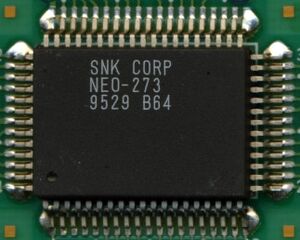NEO-273: Difference between revisions
No edit summary |
mNo edit summary |
||
| Line 1: | Line 1: | ||
[[File:crt_273.jpg|right|thumb|NEO-273 chip in a MVS [[cartridges|cartridge]]. Picture courtesy of [[http://www.mvs-scans.com MVS-Scans]].]] | [[File:crt_273.jpg|right|thumb|NEO-273 chip in a MVS [[cartridges|cartridge]]. Picture courtesy of [[http://www.mvs-scans.com MVS-Scans]].]] | ||
This chip is used in cartridges to replace 74LS273 and 74LS174 latches that were used in early boards (Like on [[CHA board|CHA-32]]). It demultiplexes the P bus to [[C ROM]] and [[S ROM]] addresses. | This chip is used in cartridges to replace 74LS273 and 74LS174 latches that were used in early boards (Like on [[CHA board|CHA-32]]). It demultiplexes the [[P bus]] to [[C ROM]] and [[S ROM]] addresses. | ||
It includes one 16-bit latch (to address a 128KiB S ROM) and one 20-bit latch (to address 8MiB of 2*16bits [[C ROM]]s) in one package. Note that A4 ( | It includes one 16-bit latch (to address a 128KiB S ROM) and one 20-bit latch (to address 8MiB of 2*16bits [[C ROM]]s) in one package. Note that A4 ({{Sig|CA4}}) of the C ROMs and A3 ({{Sig|2H1}}) of the S ROM are not part of the multiplexed bus and come straight from the cartridge edge, bypassing this chip. | ||
This chip was later replaced by [[NEO-CMC]] which performs the same function along with quite a few other things. | This chip was later replaced by [[NEO-CMC]] which performs the same function along with quite a few other things. | ||
| Line 12: | Line 12: | ||
{|class="wikitable" | {|class="wikitable" | ||
| | |||
|colspan=4|external | |||
| | |||
|colspan=24|internal | |||
|- | |||
!P BUS||P23||P22||P21||P20|| ||P19||P18||P17||P16||P15||P14||P13||P12||P11||P10||P9||P8||P7||P6||P5||P4||P3||P2||P1||P0 | !P BUS||P23||P22||P21||P20|| ||P19||P18||P17||P16||P15||P14||P13||P12||P11||P10||P9||P8||P7||P6||P5||P4||P3||P2||P1||P0 | ||
|- | |- | ||
| Line 18: | Line 23: | ||
|S address|| || || || || || || || || ||A4||A2||A1||A0||A16||A15||A14||A13||A12||A11||A10||A9||A8||A7||A6||A5 | |S address|| || || || || || || || || ||A4||A2||A1||A0||A16||A15||A14||A13||A12||A11||A10||A9||A8||A7||A6||A5 | ||
|} | |} | ||
A /C_A20 signal is available on pin 47 to allow cartridges who use 2MiB C Roms to switch between 2 pairs without an additionnal inverter chip. | |||
=Pinout= | =Pinout= | ||
[[File:Neo-273_pinout.png]] | [[File:Neo-273_pinout.png]] | ||
Revision as of 11:01, 27 December 2012

This chip is used in cartridges to replace 74LS273 and 74LS174 latches that were used in early boards (Like on CHA-32). It demultiplexes the P bus to C ROM and S ROM addresses.
It includes one 16-bit latch (to address a 128KiB S ROM) and one 20-bit latch (to address 8MiB of 2*16bits C ROMs) in one package. Note that A4 ([[Signal names#{{{2}}}|CA4]]) of the C ROMs and A3 ([[Signal names#{{{2}}}|2H1]]) of the S ROM are not part of the multiplexed bus and come straight from the cartridge edge, bypassing this chip.
This chip was later replaced by NEO-CMC which performs the same function along with quite a few other things.
For cartridges that use this chip but have more than 8MiB of C ROM, extra bits were added using 7400 chips. An added LS74 (2 bits) in CHA256 boards for example increases the C ROM capacity from 8MiB to 32MiB (256M).
Demultiplexing
| external | internal | ||||||||||||||||||||||||||||
| P BUS | P23 | P22 | P21 | P20 | P19 | P18 | P17 | P16 | P15 | P14 | P13 | P12 | P11 | P10 | P9 | P8 | P7 | P6 | P5 | P4 | P3 | P2 | P1 | P0 | |||||
|---|---|---|---|---|---|---|---|---|---|---|---|---|---|---|---|---|---|---|---|---|---|---|---|---|---|---|---|---|---|
| C address | A24 | A23 | A22 | A21 | A3 | A2 | A1 | A0 | A20 | A19 | A18 | A17 | A16 | A15 | A14 | A13 | A12 | A11 | A10 | A9 | A8 | A7 | A6 | A5 | |||||
| S address | A4 | A2 | A1 | A0 | A16 | A15 | A14 | A13 | A12 | A11 | A10 | A9 | A8 | A7 | A6 | A5 | |||||||||||||
A /C_A20 signal is available on pin 47 to allow cartridges who use 2MiB C Roms to switch between 2 pairs without an additionnal inverter chip.
Pinout
OpenOffice Draw file: File:Neo-273.odg